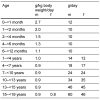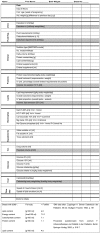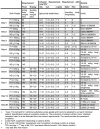Neonatology/Paediatrics - Guidelines on Parenteral Nutrition, Chapter 13
- PMID: 20049070
- PMCID: PMC2795370
- DOI: 10.3205/000074
Neonatology/Paediatrics - Guidelines on Parenteral Nutrition, Chapter 13
Abstract
There are special challenges in implementing parenteral nutrition (PN) in paediatric patients, which arises from the wide range of patients, ranging from extremely premature infants up to teenagers weighing up to and over 100 kg, and their varying substrate requirements. Age and maturity-related changes of the metabolism and fluid and nutrient requirements must be taken into consideration along with the clinical situation during which PN is applied. The indication, the procedure as well as the intake of fluid and substrates are very different to that known in PN-practice in adult patients, e.g. the fluid, nutrient and energy needs of premature infants and newborns per kg body weight are markedly higher than of older paediatric and adult patients. Premature infants <35 weeks of pregnancy and most sick term infants usually require full or partial PN. In neonates the actual amount of PN administered must be calculated (not estimated). Enteral nutrition should be gradually introduced and should replace PN as quickly as possible in order to minimise any side-effects from exposure to PN. Inadequate substrate intake in early infancy can cause long-term detrimental effects in terms of metabolic programming of the risk of illness in later life. If energy and nutrient demands in children and adolescents cannot be met through enteral nutrition, partial or total PN should be considered within 7 days or less depending on the nutritional state and clinical conditions.
Eine besondere Herausforderung bei der Durchführung parenteraler Ernährung (PE) bei pädiatrischen Patienten ergibt sich aus der großen Spannbreite zwischen den Patienten, die von extrem unreifen Frühgeborenen bis hin zu Jugendlichen mit einem Körpergewicht von mehr als 100 kg reicht, und ihrem unterschiedlichen Substratbedarf. Dabei sind alters- und reifeabhängige Veränderungen des Stoffwechsels sowie des Flüssigkeits- und Nährstoffbedarfs zu berücksichtigen sowie auch die klinische Situation, in der eine PE eingesetzt wird. Das Vorgehen unterscheidet sich deshalb ganz erheblich von der PE-Praxis bei erwachsenen Patienten, z.B. ist der Flüssigkeits-, Nährstoff- und Energiebedarf von Früh- und Neugeborenen pro kg Körpergewicht höher als bei älteren pädiatrischen und bei erwachsenen Patienten. In der Regel benötigen alle Frühgeborenen <35. SSW und alle kranken Reifgeborenen während der Phase des allmählichen Aufbaus der enteralen Nahrungszufuhr eine vollständige oder partielle PE. Die Zufuhrmengen der PE bei Neonaten müssen berechnet (nicht geschätzt) werden. Der Anteil der PE sollte zur Minimierung von Nebenwirkungen sobald wie möglich durch Einführung einer enteralen Ernährung vermindert (teilparenterale Ernährung) und schließlich komplett durch enterale Ernährung abgelöst werden. Eine unangemessene Substratzufuhr im frühen Säuglingsalter kann langfristig nachteilige Auswirkungen im Sinne einer metabolischen Programmierung des Krankheitsrisikos im späteren Lebensalter haben. Wenn bei älteren Kindern und Jugendlichen dagegen der Energie- und Nährstoffbedarf eines Patienten im Vorschul- oder Schulalter durch eine enterale Nährstoffzufuhr nicht gedeckt werden kann, ist abhängig von Ernährungszustand und klinischen Umständen spätestens innerhalb von 7 Tagen eine partielle oder totale PE zu erwägen.
Keywords: childhood; low birth weight infant; monitoring; newborn infant; premature infant.
Figures




References
-
- Koletzko B, Goulet O, Hunt J, Krohn K, Shamir R. 1. Guidelines on Paediatric Parenteral Nutrition of the European Society of Paediatric Gastroenterology, Hepatology and Nutrition (ESPGHAN) and the European Society for Clinical Nutrition and Metabolism (ESPEN), Supported by the European Society of Paediatric Research (ESPR) J Pediatr Gastroenterol Nutr. 2005;41(Suppl 2):S1–S4. doi: 10.1097/01.mpg.0000181841.07090.f4. Available from: http://dx.doi.org/10.1097/01.mpg.0000181841.07090.f4. - DOI - DOI - PubMed
-
- Friis-Hansen B. Body water compartments in children: changes during growth and related changes in body composition. Pediatrics. 1961;28:169–181. - PubMed
-
- Widdowson E. Changes of body composition during growth. In: Davis J, Dobbing J, editors. Scientific foundations of paediatrics. London: Heinemann; 1981. pp. 330–342.
-
- Fusch C, Hungerland E, Scharrer B, Moeller H. Water turnover of healthy children measured by deuterated water elimination. Eur J Pediatr. 1993;152(2):110–114. doi: 10.1007/BF02072485. Available from: http://dx.doi.org/10.1007/BF02072485. - DOI - DOI - PubMed
-
- Spitzer A. Renal physiology and function development. In: Edelmann CM, editor. The kidney and urinary tract. Boston: Little Brown; 1978. pp. 25–128.
Publication types
MeSH terms
LinkOut - more resources
Full Text Sources
Other Literature Sources
Medical
Miscellaneous

